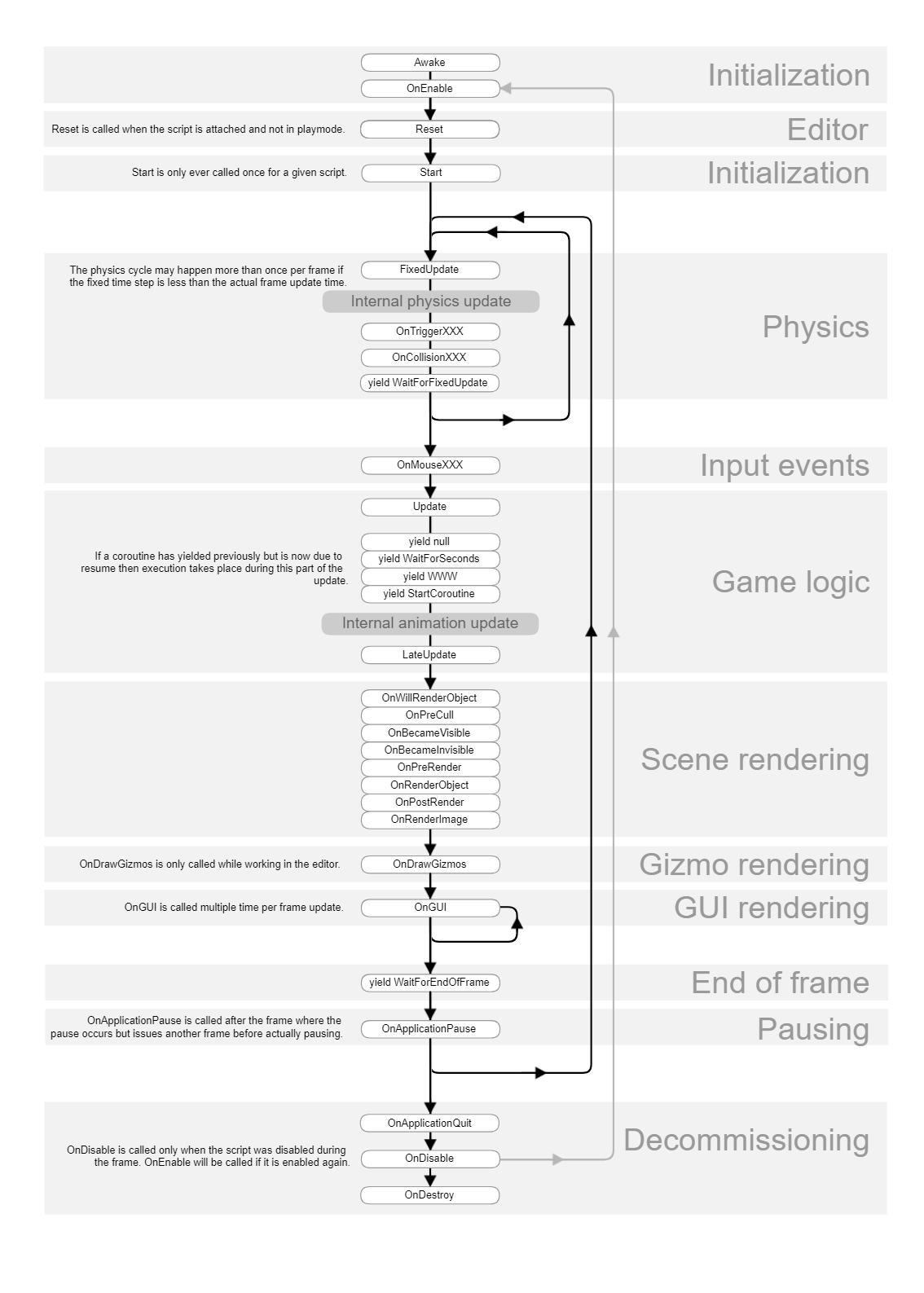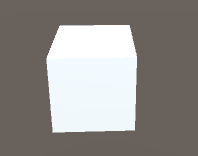unity常用API(一)
个人英语不好,所以看的是2018.1 的中文API 部分代码和解释都来源于此文档:原文链接
视频链接:点击链接
unity自带的一些函数
-
Awake:始终在任何 Start 函数之前并在实例化预制件之后调用此函数。(如果游戏对象在启动期间处于非活动状态,则在激活之后才会调用 Awake。)
-
Start:不是很紧急的初始化,一般放在Start里面来做。仅在Update函数第一次被调用前调用
-
Reset:调用 Reset 可以在脚本首次附加到对象时以及使用 Reset 命令时初始化脚本的属性
-
Update:每帧调用一次 Update。这是用于帧更新的主要函数。
-
FixedUpdate:以相同时间间隔调用,用在力学更新效果中。执行在Update之前。
-
LateUpdate:在Update和FixedUpdate调用之后调用。一般人物的移动放在Update中,而摄像机的跟进变化放到FixedUpdate中。确保两个独立。
-
OnDestory:物体被删除时调用。
-
OnEnable:(仅在对象处于激活状态时调用)在启用对象后立即调用此函数。在创建 MonoBehaviour 实例时(例如加载关卡或实例化具有脚本组件的游戏对象时)会执行此调用。
-
OnDisable:物体被禁用时调用。
调用顺序:

Time类
-
deltaTime: 完成上一帧所用的时间(以秒为单位)(只读)。
-
fixedDeltaTime:执行物理和其他固定帧率更新(如 MonoBehaviour 的 FixedUpdate)的时间间隔(以秒为单位)。
-
fixedTime:最近一次 FixedUpdate 已启动的时间(只读)。此为自游戏启动以来的时间(以秒为单位)。
-
frameCount:已经过的总帧数(只读)。
-
realtimeSinceStartup:游戏开始以来的实际时间(只读)。
-
smoothDeltaTime:经过平滑处理的 Time.deltaTime(只读)。
-
time:该帧开始的时间(只读)。此为自游戏启动以来的时间(以秒为单位)。
-
timeScale:时间流逝的缩放。可用于慢动作效果。
-
timeSinceLevelLoad:该帧开始以来的时间(只读)。此为自加载上一个关卡以来的时间(以秒为单位)。
测试性能
float timeStart = Time.realtimeSinceStartup;
for (int i = 0; i < 10000; i++)
{
Method();
}
float timeEnd = Time.realtimeSinceStartup;
Debug.Log(timeEnd-timeStart);
使物体向前移动
cube.transform.Translate(Vector3.forward * Time.deltaTime);
GameObject 类
-
创建物体的三种方式
// 第一种 GameObject go= new GameObject("cube"); // 克隆一个已有的 GameObject.Instantiate(prefab); // 创建基本的物体 GameObject go =GameObject.CreatePrimitive(PrimitiveType.Cube); -
添加组件
// 添加刚体 go.AddComponent<Rigidbody>(); // 添加 脚本 go.AddComponent<API01Event>(); // API01Event 是脚本 -
activeInHierarchy:定义 GameObject 在 Scene 中是否处于活动状态。
Debug.Log(go.activeInHierarchy); // True go.SetActive(false); Debug.Log(go.activeInHierarchy); // False -
Tag:此游戏对象的标签。
-
name:对象的名称。
Debug.Log(go.name); Debug.Log(go.GetComponent<Transform>().name)//获取组件的名字其实获取的是物体的名字 -
layer: 该游戏对象所在的层。
-
scene:该 GameObject 所属的场景。
Public Functions
-
AddComponent : 将名为 className 的组件类添加到该游戏对象。
go.AddComponent<Rigidbody>(); -
ComPareTag : 如果游戏对象附加了类型为 type 的组件,则将其返回,否则返回 null。
-
SetActive : 激活/停用此 GameObject。
-
SendMessage : 调用此游戏对象中的每个 MonoBehaviour 上名为 methodName 的方法。
-
BroadcastMessage : 调用此游戏对象或其任何子项中的每个 MonoBehaviour 上名为 methodName 的方法。
target.BroadcastMessage("Attack",null,SendMessageOptions.DontRequireReceiver);//如果有接受者则发送,如果没有不报错 void Attack() //当一个物体的脚本里拥有此方法则会被调用(子类也会调用) { Debug.Log(this.gameObject + "正在攻击"); } -
SendMessageUpwards : 调用此游戏对象中的每个 MonoBehaviour 上或此行为的每个父级上名为 methodName 的方法。
-
GetCompont:如果游戏对象附加了类型为 type 的组件,则将其返回,否则返回 null。
Cube cube = target.GetComponent<Cube>(); //类 Transform t = target.GetComponent<Transform>(); -
GetComponts: 返回 GameObject 中类型为 type 的所有组件。
Cube[] cubes = target.GetComponents<Cube>(); cubes = target.GetComponentsInChildren<Cube>(); foreach(Cube c in cubes) { Debug.Log(c); } -
GetComponentsInChildren: 使用深度首次搜索返回 GameObject 或其任何子项中类型为 type 的组件。
-
GetComponentsInParant: 返回 GameObject 或其任何父项中类型为 type 的组件。
Cube cube = target.GetComponent<Cube>(); // 获取单个
Transform t = target.GetComponent<Transform>();
Debug.Log(cube);
Debug.Log(t);
Debug.Log("---------------------------------");
Cube[] cubes = target.GetComponents<Cube>(); // 获取多个
Debug.Log(cubes.Length);
Debug.Log("---------------------------------");
cubes = target.GetComponentsInChildren<Cube>(); // 自己以及子类
foreach (Cube c in cubes)
{
Debug.Log(c);
}
Debug.Log("---------------------------------");
cubes = target.GetComponentsInParent<Cube>();
foreach (Cube c in cubes)
{
Debug.Log(c);
}
Static Functions
-
CreatePrimitive : 创建一个具有原始网格渲染器和相应碰撞体的游戏对象.
-
Find : 按 name 查找 GameObject,然后返回它。
GameObject go = GameObject.Find("Main Camera"); -
FindGameObjectWithTag : 返回标记为 tag 的活动 GameObject 的列表。如果未找到 GameObject,则返回空数组。
GameObject[] gos= GameObject.FindGameObjectsWithTag("MainCamera"); -
Destroy : 删除 GameObject、组件或资源。 不会被立即回收
Destroy(this);(一般是脚本)(可以销毁物体也可以销毁组件) Destroy(gameObject,5); //(5秒后销毁) -
DontDestroyOnLoad:加载新场景时,不自动销毁对象 /target/。
-
FindObjectOfType:返回第一个类型为 type 的已加载的激活对象。
-
FindObjectsOfType:返回所有类型为 type 的已加载的激活对象的列表。
Light light =FindObjectOfType<Light>(); //获取所有的灯 light.enabled = false;
MonoBehaviour
-
Invoke : 在 time 秒后调用 methodName 方法。
Invoke("Attack", 3); void Update () { bool res = IsInvoking("Attack"); print(res); } void Attack() { Debug.Log("正在攻击目标"); } -
InvokeRepeating : 在 time 秒后调用 methodName 方法,然后每 repeatRate 秒调用一次。
InvokeRepeating("Attack", 4, 2);//第四秒开始调用第一次,之后每2秒调用一次 -
CancleInvoke : 取消该 MonoBehaviour 上的所有 Invoke 调用。
CancelInvoke("Attack");
协程
-
在使用协程的时候需要有以下几个关键词:
- 函数返回值是IEnmerator
- 函数返回时要使用 yield return xxx
- 调用协程方法时 我们要使用StartCoroutine(xxx())
public GameObject cube; private void Update() { if (Input.GetKeyDown(KeyCode.Space)) { StartCoroutine(Fade()); } } IEnumerator Fade() { for (float i = 0; i <= 1; i += 0.1f) { // 第一种方式 //cube.GetComponent<MeshRenderer>().material.color = new Color(i,i,i,i); // 第二种方式 Color color = cube.GetComponent<MeshRenderer>().material.color; Color newColor = Color.Lerp(color, Color.black,0.1f); // 向黑色逐渐靠近 cube.GetComponent<MeshRenderer>().material.color = newColor; yield return new WaitForSeconds(0.1f); // 暂停 } }
- StopCoroutine : 停止在该行为上运行的第一个名为 methodName 的协同程序或存储在 routine 中的协同程序
// 第一种停止方式 Coroutine A = StartCoroutine(coroutineA()); StopCoroutine(A); // 第二种停止方式 IEnumerator DemoFuntion(){ ... } IEnumerator coroutine = DemoFuntion(); StartCoroutine(coroutine); StopCoroutine(coroutine); - **StopAllCoroutines : 停止在该行为上运行的所有协程。
